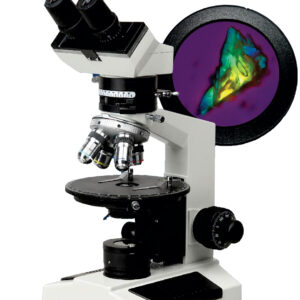Petrological Microscope QMM-500
Viewing Head: 30 degree inclined fixed Trinocular Head
Mechanical Stage: 360 degree rotating circular stage
Observation Technique: (Transmitted light Bright Field (BF), Dark Field (DF) & Polarization (POL) and phase contrast techniques
Eyepiece: A pair of WF 10X/22mm FOV.
Description
Polarized light microscopy can mean any of a number of optical microscopy techniques involving polarized light. Simple techniques include illumination of the sample with polarized light. Directly transmitted light can, optionally,
be blocked with a polariser orientated at 90 degrees to the illumination. More complex microscopy techniques which take advantage of polarized light
include differential interference contrast microscopy and interference reflection microscopy. Scientists will often use a device called a polarizing
plate to convert natural light into polarized light.
These illumination techniques are most commonly used on birefringent samples where the polarized light interacts strongly with the sample and so generatincontrast with the background. Polarized light microscopy is used extensively in optical mineralogy
SPECIFICATIONS:
| Optical System | High Contrast Infinity corrected Optical System |
| Body
|
Polarized light microscopy can mean any of a number of optical microscopy techniques involving polarized light. Simple techniques include illumination of the sample with polarized light. Directly transmitted light can, optionally, be blocked with a polariser orientated at 90 degrees to the illumination. More complex microscopy techniques which take advantage of polarized light include differential interference contrast microscopy and interference reflection microscopy. Scientists will often use a device called a polarizing plate to convert natural light into polarized light. These illumination techniques are most commonly used on birefringent samples where the polarized light interacts strongly with the sample and so generatin contrast with the background. Polarized light microscopy is used extensively in optical mineralogy |
| Viewing Head
|
: Binocular / Trinocular head inclined at 30° with IPD 50-75mm with dioptric adjustment eyepiece locking mechanism, and orientation key in one eye tube for the Crosshair reticule eyepiece |
| Magnification
|
40X-1000X |
| Eyepiece
|
Wide Field 10x eye-piece with 22mm F.O.V, with eye guards anti-fungal & anti-reflection hard coated with crosshair reticule and key for orientation |
| Objective
|
Infinity polarizing achromatic free working distance objectives for use with and without cover glass for all magnifications 4x/0.10 Pol, 10x/0.25 Pol, 40x/0.65 Pol. (optional 60x/0.80) suitable for Transmitted and reflected light applications |
| Condenser
|
: POL condenser NA 0.85 with aspheric lens. Iris diaphragm antifungal & antireflection coated. Rack and pinion movements on stainless steel guides |
| Mechanical Stage
|
Circular rotating stage with graduations and adjustable brake, Polarizing stage 170 mm diagram with object guide Object guide for Pol-Stages with XY- Control suitable for different slide formats Division: 0.1mm Low drive right side movement |
| Focusing Control
|
Co-axial coarse and fine focusing on gear systems for smooth operation. Fine adjustment 0.2mm / rotation with maximum 2 micron scale increment |
| Nose piece
|
:Quardruple revolving nose-piece ball bearing type with proper click stops centerable nosepiece for all position. 530nm Lambda Nosepiece Compensator and Objective centering tools: 2 Object Clamps |
| Conoscopy
|
Analyzer/Bertrand Lens Module w/Focusable Bertrand Lens |
| Illumination
|
Koehler Illumination Q-LED 3.5W 3V continuous intensity adjustment Up to 60,000 hours of LED life, built in handle and cord wrap. Auto shut-off function ir sensor |
| Certification
|
Has ISO,CE and European CE Certificate. |
| Electronics
|
Koehler Universal input 110V – 240V AC, 50/60 Hz |
| Accessories
|
Dustcover, lens cleaning solution, 5x eyepiece, Operation Manual. spare fuse, cleaning solution 100ml. |




